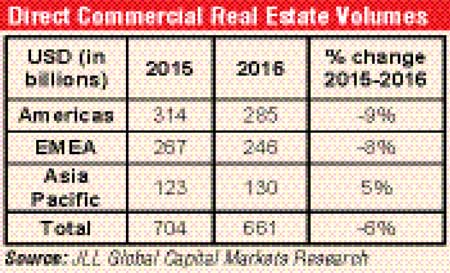Saturday Dec 14, 2024
Saturday Dec 14, 2024
Friday, 21 April 2017 00:00 - - {{hitsCtrl.values.hits}}

Latest data from JLL’s Global Capital Markets Research team reveals how Asia Pacific was the only region to see an increase in transactional activity, rising by 5%, while the Americas and Europe both felt the effects of political turbulence, falling 9% and 8% respectively. The last quarter of 2016 saw global transactional volumes of $ 206 billion – a reduction of 2% compared to the same period in 2015 – bringing the full year 2016 volumes to $ 661 b, a 6% decline from 2015’s $ 704 b.
Ironically, much of the pullback happened in the first part of 2016, before BREXIT and the US elections. Overall, the US still managed to maintain its dominance of cross-border capital flows, although China has moved into a clear second place, with over $ 22 b exported in 2016, primarily into the office and hotel sectors.
New York, for a second year in a row, was the most traded city globally. For the first time in many years, the top city rankings were disrupted with Los Angeles and Shanghai pushing into the top five, while Paris and Tokyo slipped back. While the influence of Chinese capital within global real estate has been a point of discussion, its domestic market is also taking strides.
At the end of 2016, China has become the fourth biggest market globally, surpassing Japan to become the biggest investment market in Asia-Pacific (see graph below). The final quarter of 2016 was the busiest ever recorded in China at $ 16 b, with a couple of mega deals in Shanghai and Beijing partly responsible.
Within Europe, Germany almost surpassed the UK to become the regions’ biggest market. Ultimately, however, it fell just short as the UK had a more active final quarter than anticipated, although volumes are down almost 40% from last year. This has dragged the regional performance down by 8% from 2015 with the majority of the positive outperformance coming from Central and Eastern Europe.
In the Americas, all of the countries in our coverage under-performed against 2015’s activity, with Canada being best of the bunch with a 5% drop. Regionally, volumes have dropped below $ 300 b for the first time in three years, with the rise in the US 10-year bond yield certainly affecting investor behaviour in the final few weeks of the year.
The uncertain political environment of 2016 is set to continue into 2017 and the outcomes may be even more surprising. Through it all, real estate assets have continued to attract capital, not only as a preserver of value but also as a key part of a diversified global investment portfolio. The global capital market environment is adjusting to a forecast higher interest rate outlook and in previous cycles, this may have seen institutional capital switch away from real estate, but for 2017, we expect global transactional volumes to be similar to 2016 at $ 660 bn with the possibility of a move towards $ 700 bn if global economic growth improves.
Indian real estate has attracted $ ~32 billion in private equity so far. The global capital flow into Indian real estate in 2016 stood at $ ~5.7 billion. Though the historic high of 2007 (in terms of total PE inflows) was not breached, last year proved to be the second best year so far. Despite Brexit and uncertainty around the new US president’s outsourcing and visa-related policies, private equity activity looks healthy in 2017 too – thanks to a strengthening and modernising economy and the growing reputation of India as an attractive investment destination.
India’s tier-I cities moved up to the 36th rank in JLL’s 2016 Global Real Estate Transparency Index – a bi-annual index – on the back of improvements in structural reforms and a more liberal foreign direct investment (FDI) regime. Increase in transparency results in higher investment in such real estate markets. Thanks to changes in its regulatory framework, India is now looking way more attractive to investors – both foreign and domestic – than it was ever before.
Increased consolidation as well as transparency and launching of REITs (Real Estate Investment Trusts) in 2017 are some of the important developments expected to boost foreign and domestic investor participation further.